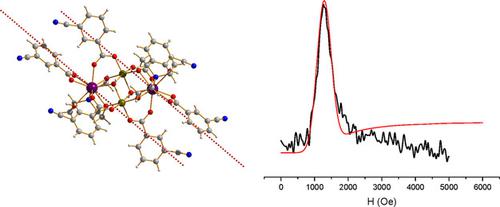当前位置:
X-MOL 学术
›
Chem. Eur. J.
›
论文详情
Our official English website, www.x-mol.net, welcomes your feedback! (Note: you will need to create a separate account there.)
Magnetization Blocking in Fe2IIIDy2III Molecular Magnets: Ab Initio Calculations and EPR Spectroscopy
Chemistry - A European Journal ( IF 4.3 ) Pub Date : 2018-10-17 , DOI: 10.1002/chem.201803821 Veacheslav Vieru 1 , Liviu Ungur 1, 2 , Valeriu Cemortan 1 , Andrey Sukhanov 3 , Amer Baniodeh 4 , Christopher E. Anson 4 , Annie K. Powell 4, 5 , Violeta Voronkova 3 , Liviu F. Chibotaru 1
Chemistry - A European Journal ( IF 4.3 ) Pub Date : 2018-10-17 , DOI: 10.1002/chem.201803821 Veacheslav Vieru 1 , Liviu Ungur 1, 2 , Valeriu Cemortan 1 , Andrey Sukhanov 3 , Amer Baniodeh 4 , Christopher E. Anson 4 , Annie K. Powell 4, 5 , Violeta Voronkova 3 , Liviu F. Chibotaru 1
Affiliation

|
The magnetism and magnetization blocking of a series of [Fe2Dy2(OH)2(teaH)2(RC6H4COO)6] complexes was investigated, in which teaH3=triethanolamine and R=meta‐CN (1), para‐CN (2), meta‐CH3 (3), para‐NO2 (4) and para‐CH3 (5), by combining ab initio calculations and EPR measurements. The results of broken‐symmetry DFT calculations show that in all compounds the Fe–Fe exchange interaction is antiferromagnetic and stronger by far than the Fe–Dy and Dy–Dy interactions. As a result, the lowest two exchange doublets probed by EPR spectroscopy mostly originate from the Ising interaction of the dysprosium ions in all compounds. A correct quantitative description of the splitting of these two doublets requires, however, an explicit account of the Fe–Dy and Fe–Fe interactions. Due to the inversion symmetry of the complexes, the doublets under consideration are described by a collinear Ising exchange interaction. This picture is also supported by the EPR spectra, which could be simulated with parameters close to those extracted from the calculations. The magneto‐structural analysis shows an increase of the antiferromagnetic Fe–Fe exchange interaction with increasing Fe‐O‐Fe angle and Fe–Fe distance. For the Dy–Fe interaction, the opposite tendency is observed, that is, a decrease of antiferromagnetic exchange coupling with increasing Dy‐O‐Fe angle and Dy–Fe distance. The transversal g factors extracted from the ab initio calculations have values in the range of 0.01–0.2, testifying to the lack of high axiality of the ground state of the dysprosium ions. This explains the lack/poor single‐molecule magnetic behavior of this series of compounds at the investigated temperatures of a few Kelvin. Due to a very small gap (fractions of a wavenumber) between the ground and first‐excited exchange doublet, relaxation takes place by magnetic moment reversal at individual dysprosium sites in the considered temperature domain.
中文翻译:

Fe2IIIDy2III分子磁体中的磁化阻断:从头算和EPR光谱
研究了一系列[Fe 2 Dy 2(OH)2(teaH)2(RC 6 H 4 COO)6 ]配合物的磁性和磁化阻断,其中teaH 3 =三乙醇胺,R =间-CN(1) ,para- CN(2),meta- CH 3 (3),para- NO 2 (4)和para- CH 3 (5),结合使用从头算和EPR测量。断裂对称DFT计算结果表明,在所有化合物中,Fe-Fe交换相互作用都是反铁磁性的,并且远比Fe-Dy和Dy-Dy相互作用强。结果,通过EPR光谱探测的最低的两个交换双峰主要来自所有化合物中the离子的Ising相互作用。然而,对这两个双峰分裂的正确定量描述需要明确地说明Fe-Dy和Fe-Fe的相互作用。由于络合物的反对称性,所考虑的双峰通过共线的伊辛交换相互作用来描述。EPR光谱也支持此图片,可以使用与从计算中提取的参数接近的参数对其进行仿真。磁结构分析表明,反铁磁性Fe-Fe交换相互作用随着Fe-O-Fe角和Fe-Fe距离的增加而增加。对于Dy-Fe相互作用,观察到相反的趋势,即随着Dy-O-Fe角和Dy-Fe距离的增加,反铁磁交换耦合减小。横向从头算计算得出的g个因子的值在0.01-0.2范围内,这证明test离子基态缺乏高轴向性。这解释了该系列化合物在几个开尔文研究温度下缺乏/不良的单分子磁性行为。由于地面和首次激发交换双峰之间的缝隙非常小(波数的分数),因此在考虑的温度域中,各个individual位置的磁矩反转会引起弛豫。
更新日期:2018-10-17
中文翻译:

Fe2IIIDy2III分子磁体中的磁化阻断:从头算和EPR光谱
研究了一系列[Fe 2 Dy 2(OH)2(teaH)2(RC 6 H 4 COO)6 ]配合物的磁性和磁化阻断,其中teaH 3 =三乙醇胺,R =间-CN(1) ,para- CN(2),meta- CH 3 (3),para- NO 2 (4)和para- CH 3 (5),结合使用从头算和EPR测量。断裂对称DFT计算结果表明,在所有化合物中,Fe-Fe交换相互作用都是反铁磁性的,并且远比Fe-Dy和Dy-Dy相互作用强。结果,通过EPR光谱探测的最低的两个交换双峰主要来自所有化合物中the离子的Ising相互作用。然而,对这两个双峰分裂的正确定量描述需要明确地说明Fe-Dy和Fe-Fe的相互作用。由于络合物的反对称性,所考虑的双峰通过共线的伊辛交换相互作用来描述。EPR光谱也支持此图片,可以使用与从计算中提取的参数接近的参数对其进行仿真。磁结构分析表明,反铁磁性Fe-Fe交换相互作用随着Fe-O-Fe角和Fe-Fe距离的增加而增加。对于Dy-Fe相互作用,观察到相反的趋势,即随着Dy-O-Fe角和Dy-Fe距离的增加,反铁磁交换耦合减小。横向从头算计算得出的g个因子的值在0.01-0.2范围内,这证明test离子基态缺乏高轴向性。这解释了该系列化合物在几个开尔文研究温度下缺乏/不良的单分子磁性行为。由于地面和首次激发交换双峰之间的缝隙非常小(波数的分数),因此在考虑的温度域中,各个individual位置的磁矩反转会引起弛豫。



























 京公网安备 11010802027423号
京公网安备 11010802027423号